Operational Efficiency in Higher Education: Unlocking Time, Budget, and Value with AI
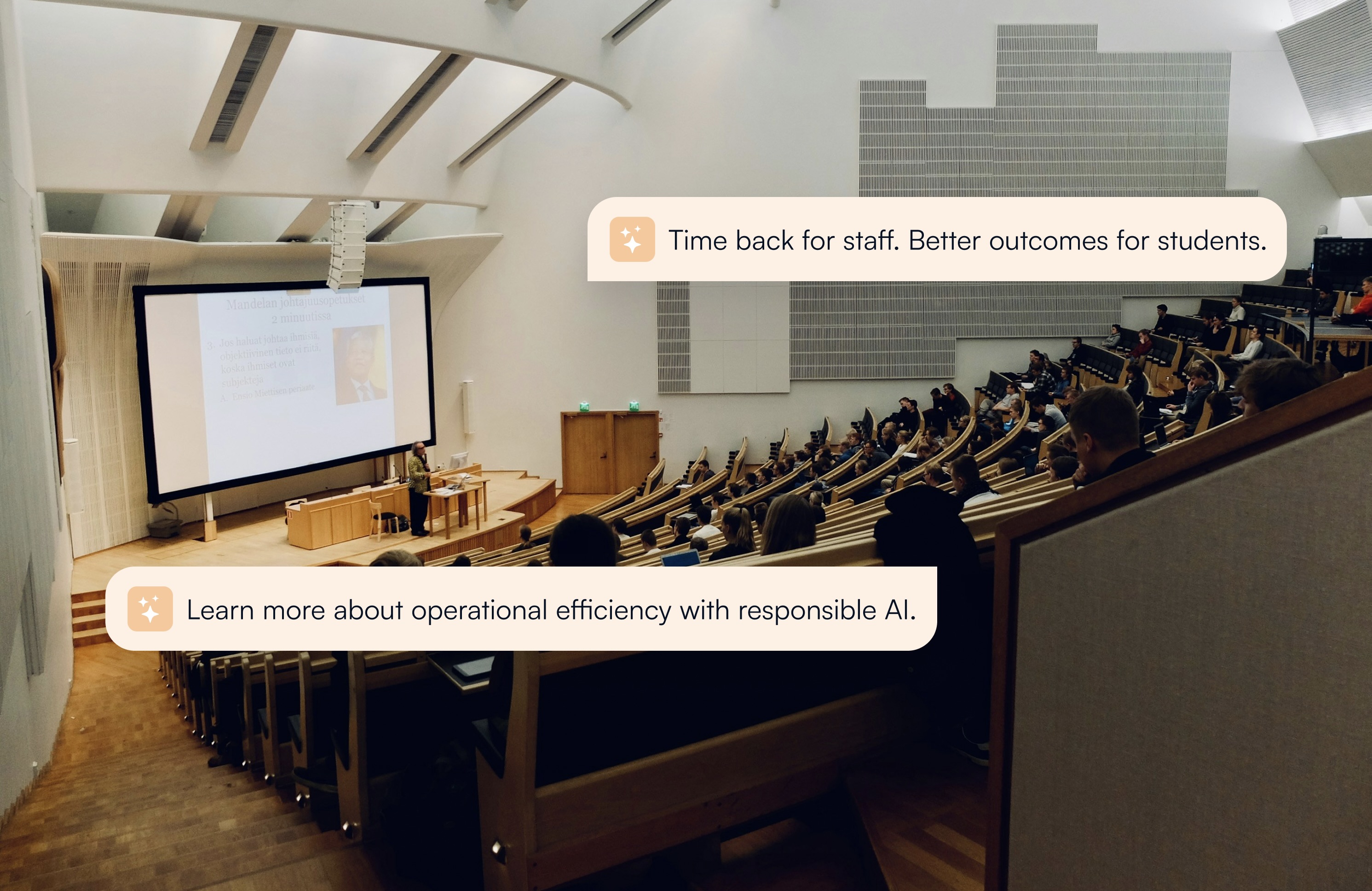
Introduction: Why Operational Efficiency Is Higher Ed’s Most Urgent (and Underestimated) AI Use Case
In 2025, higher education institutions are navigating a paradox: they’re being asked to deliver more personalized, accessible, and tech-enabled learning, while operating with tighter budgets, overburdened staff, and rapidly shifting expectations from students and faculty alike.
For many, AI has entered the conversation through the lens of innovation: experimental pilots, chatbot trials, or exploratory research. But for CIOs, registrars, academic leaders, and support teams, AI's most immediate and measurable value may not come from pedagogical breakthroughs, but from operational efficiency.
The reality is stark:
- Staff workloads are rising while headcount remains flat
- Faculty face growing pressures to respond faster, grade more consistently, and support more students
- IT and student services teams field thousands of routine queries every term
- Knowledge is fragmented across portals, PDFs, and internal sites—creating bottlenecks for both students and staff
Institutions don’t just need “smarter” tools. They need systems that save time, reduce repetitive work, and create cost clarity across departments.
This is where LearnWise AI focuses. Built as an LMS-native platform, LearnWise supports student self-service, staff efficiency, and feedback automation without compromising academic control or compliance. Its tools are designed not just to augment learning, but to measurably reduce operational strain across teaching, support, and service functions.
In this guide, we’ll explore:
- How AI can reclaim hours for faculty, staff, and student-facing teams
- Where institutions are seeing real ROI through AI-enabled automation
- Why a platform approach (not a patchwork of chatbots) is key to sustainable adoption
- The metrics that matter when evaluating AI’s value, now and for the long term
Because in higher ed, efficiency isn’t just an outcome. In 2025, it’s the starting point for meaningful, scalable, and responsible AI adoption.
Chapter 1: Reclaiming Time - How AI Frees Academic and Administrative Capacity
Higher education institutions are facing pressure on multiple fronts: tighter budgets, growing student expectations, complex regulation, and increasing scale of operations. At the same time, faculty and staff report rising workloads, burnout risks, and time‑to‑service delays. According to the EDUCAUSE 2025 AI Landscape Study, more than 80% of higher‑ed professionals are already using AI in some work‑related task—primarily to summarize content (74%) and brainstorm (71%).
This sets a clear opportunity: if AI is already in use, the next step is to use it strategically not just for teaching & learning, but for operational efficiency. A recent review found that intelligent systems in higher education reduced administrative processing times by up to 50%. To convert that potential into institutional value means focusing on time, budget, and value, exactly the trifecta at the heart of operational efficiency.
1.1 Faculty Time Saved Through AI‑Driven Feedback and Support
One major drain on capacity is the cycle of student queries, assignment clarifications, repetitive support tickets, and grading bottlenecks. Certain AI‑enabled tools allow institutions to reduce repetitive tasks and preserve faculty focus for higher‑value work. For instance, AI assistants embedded in LMS platforms can pre‑empt common student questions (e.g., “What is required for this assignment?”) and route more complex issues to humans, reducing the support burden.
With LearnWise AI, institutions benefit from a unified platform that supports student self‑service, feedback automation, and staff routing - all within the LMS. Partners have reported reduction in Tier-1 support queries with up to 94.4% AI Resolution rate, with as few as 23 conversations out of 400+ escalated to humans, making for a faster time-to-resolution. These time savings translate into real financial value: when faculty spend fewer hours on repetitive tasks, the institution can redeploy resources to innovation, higher‑impact teaching, and strategy.
1.2 Administrative Workflow Efficiency and Cost Avoidance
Administrators across admissions, student services, IT support, and academic operations face similar strains. According to the 2024 Ellucian AI in Higher Education Report, 80% of administrators cited “boost efficiency and productivity” as their primary motivation for AI adoption. When AI automates routine workflows such as FAQ chatbots, knowledge‑base search, or ticket triage, it enables a leaner service model.
LearnWise consolidates disparate knowledge sources (LMS modules, SharePoint, FAQs, policy pages) into a conversational interface. This reduces duplication of effort, lowers overhead for support staff, and offers tracking dashboards showing how many self‑service interactions succeeded versus escalated. That means fewer seat licences, less overhead, and a clearer picture of service metrics.
1.3 Time‑to‑Value: Why Speed Matters in EdTech Implementation
Efficiency gains are most meaningful when they happen early. Institutions that wait six to twelve months for deployment risk losing momentum, ROI, and stakeholder buy-in. A piece from Times Higher Education noted that while AI has great promise, many institutions struggle with where to start and how to measure early wins. With LearnWise’s LMS‑embedded architecture and pre‑built integrations, implementation timelines are compressed, and results (e.g., ticket deflection, student engagements) are visible in the first term.
1.4 Translating Time Saved into Budget and Value
Utilizing AI tools enable institutions to expand their capacity, allowing them to invest time and resources in other priorities. Faculty, for example, can dedicate more time to academic research and providing the kind of personalized support that helps students thrive. Institutions may also be enabled to invest resources in new initiatives across departments - including support staff.
In particular, support staff can help students with more complex issues while allowing AI solutions to improve enrollment and retention - simply by reaching students wherever they are and resolving their most pressing questions with vetted institutional knowledge.
Through the speed and quality of AI support, students can receive the assistance they need - across the LMS, in their institution website, speed and quality of this support, students can remain engaged, allowing institutions to make a bigger impact across a wider range of priorities.
Chapter 2: AI Knowledge Management - From Content Chaos to Conversational Intelligence
If your students or staff can't find the answer, it might as well not exist.
In most institutions, essential knowledge lives in a fragmented ecosystem: LMS modules, SharePoint folders, LibGuides, outdated PDFs, and buried helpdesk portals. The average student needs to consult 5+ different systems to complete a single task like registering for a course, understanding an assignment, or accessing support services. For staff, the story is the same; duplicated responses, delayed answers, and siloed content across departments. This knowledge sprawl isn’t just inefficient, but expensive.
2.1 The Problem: Content Exists, But Support Bottlenecks Persist
Many support queries, both student- and staff-initiated, are fully answerable with existing institutional content. The problem isn’t lack of information. It’s lack of findability, clarity, and access at the point of need.
According to EDUCAUSE, "findability and information retrieval” were among the top pain points identified by students interacting with digital systems in higher education.
Meanwhile, staff are forced to respond manually to routine questions like:
- “Can I submit this assignment late?”
- “Where do I upload this form?”
- “What happens if I miss this deadline?”
Each repeated answer is a hidden cost, eating into valuable staff time, reducing service consistency, and frustrating students who expect real-time support.
2.2 The Solution: AI-Powered Knowledge Management
LearnWise addresses this through a retrieval-augmented, LMS-agnostic assistant that unifies institutional content into a single conversational interface.
It does three things differently from traditional chatbots or static FAQs:
- Grounded in Real Content: LearnWise ingests SharePoint pages, LMS course content, policy docs, and custom knowledge bases. This ensures every answer is backed by institutional truth, not external internet data.
- Role-Aware Contextual Delivery: Students, instructors, and advisors get different answers based on their role and permissions. A student might see assignment clarifications, while an advisor gets policy routing options or ticket triage links.
- Feedback-Driven Improvement: Interactions are logged (compliantly), flagged for inaccuracies, and fed back into content refinement cycles. Institutions can see where content is unclear, missing, or out-of-date, turning the AI assistant into a content quality engine.
2.3 Case Study: TU Delft Extension School
The TU Delft Extension School serves over 200,000 learners annually, offering MOOCs, short courses, and online degree programs to a global audience. As enrollment and international reach expanded, so did the institution’s support burden. A small central team faced a surge in repetitive inquiries related to course access, registration, pricing, deadlines, and platform navigation, all while managing tight budgets and aiming to preserve a high-quality learner experience.
In response, TU Delft partnered with LearnWise to launch LiLLian, a multilingual AI support assistant, in early 2025. LiLLian was embedded directly into the Extension School’s website, later expanding to include LMS-facing environments. Unlike generic chatbot tools, the assistant was built on scoped, institution-approved knowledge sources, such as policy documents, FAQs, and learner support content. This approach minimized hallucinations and ensured all responses were compliant, consistent, and context-aware.
A Strategic Rollout Focused on Impact
The initial deployment targeted the highest-traffic channel—TU Delft’s Learning for Life website, which receives over 300,000 visitors annually. This choice allowed the team to immediately deflect routine queries and validate user engagement before scaling to additional platforms like Brightspace and SharePoint.
LiLLian was integrated with TU Delft’s ticketing system (FAQtory) to ensure smooth escalation pathways when human support was needed. This alignment of AI and live service allowed the assistant to act as a true front line of support—available 24/7 and responsive across languages.
Results After Six Months (March–September 2025)
A data dashboard included in the case study reveals the full impact of the deployment:
- 97.9% resolution rate without human escalation
- Over 1,000 unique users, with 1,318 AI answers provided
- Only 22 conversations required human follow-up
- 56.5% answer rating positivity, reflecting user satisfaction
- Average of 1.1 conversations per user and 1.3 messages per session
- Over 550 shortcut buttons were used—highlighting design effectiveness for common queries
These numbers confirmed the assistant’s ability to handle scale without sacrificing quality.
Key Outcomes: Efficiency, Scalability, and Insights
TU Delft’s use of LearnWise AI unlocked benefits across four strategic areas:
- Enhanced User Experience: Learners received accurate, fast, and multilingual support without navigating complex portals or waiting for staff responses.
- Operational Efficiency: The assistant meaningfully reduced repetitive queries, allowing staff to focus on complex cases and high-value tasks.
- Scalability: The AI scaled with rising user numbers without increasing support costs or response times.
- Data-Driven Insights: Interaction analytics flagged content gaps and guided iterative updates to the institutional knowledge base.
Governance and Future Plans
TU Delft’s rollout was also underpinned by strong AI governance principles:
- Only institution-approved content was used for training
- Analytics informed content improvement cycles
- IT overhead remained low thanks to standards-based integration (SSO, LTI 1.3)
Looking ahead, the Extension School plans to expand LearnWise’s footprint into:
- OpenEdX LMS integration
- Instructor and internal staff assistants
- Personalized in-LMS support for enrolled learners
- End-to-end lifecycle support, from admission to completion
The TU Delft Extension School's case showcases how AI, when deployed with strategic intent and strong governance, can significantly enhance learner experience while improving institutional operational efficiency at scale.
2.4 Going Beyond Search: Why Chat Is the Interface of Efficiency
While institutions invest in knowledge bases and static portals, students and staff increasingly expect search-free interfaces. They want answers, not navigation. They want clarity, not a 12-page PDF.
LearnWise transforms institutional content into real-time support via:
- Conversational agents embedded in LMS, SharePoint, and other student portals
- Multilingual AI with fallbacks to human staff when needed
- Analytics dashboards that track usage, accuracy, and escalation rates
This not only improves the student experience, but also reveals internal knowledge gaps and duplication across services.
2.5 Strategic Outcomes
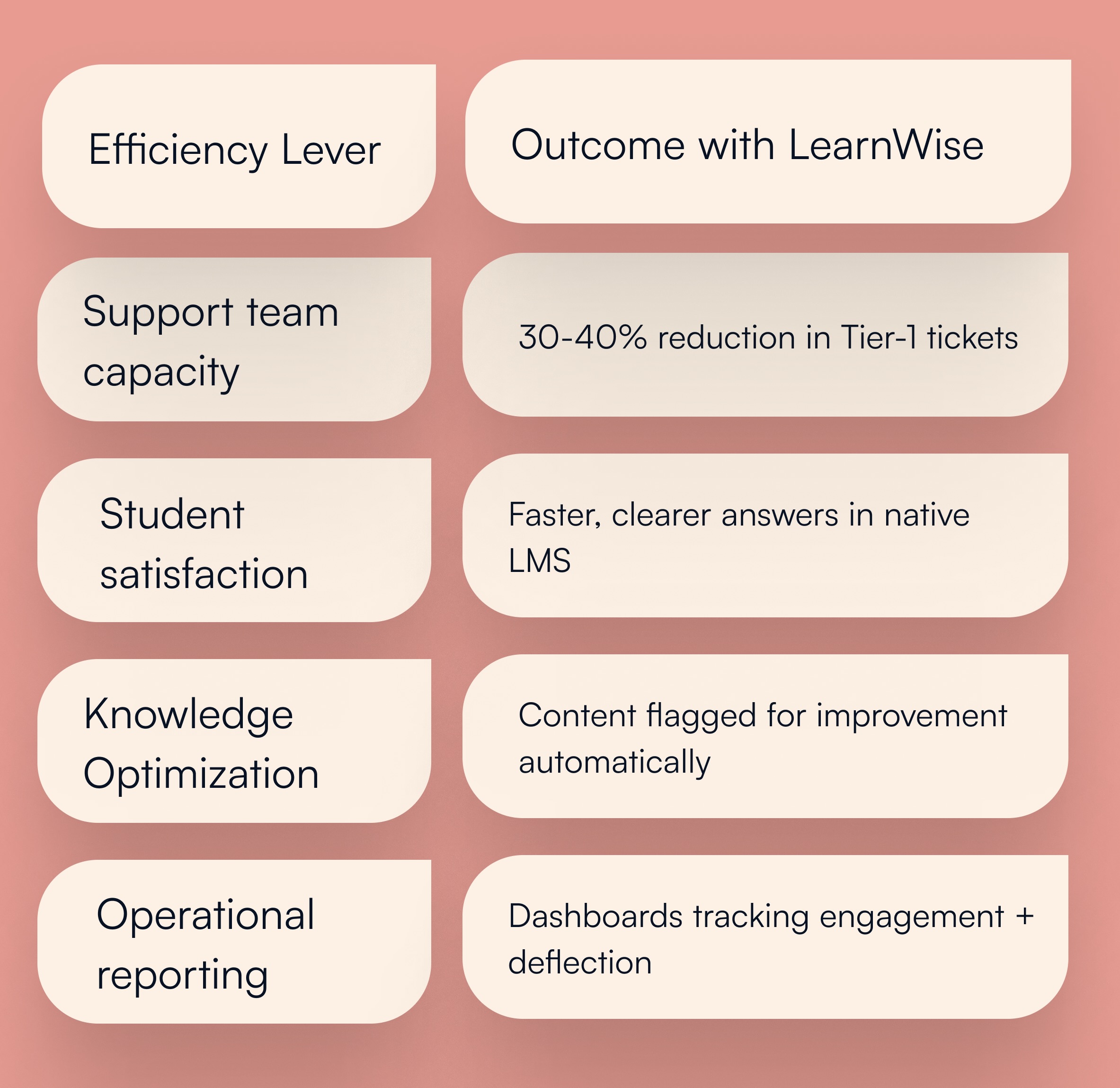
By making institutional knowledge usable, visible, and scalable, AI knowledge management becomes the cornerstone of operational efficiency, not just for IT, but for the whole campus.
Chapter 3: Measuring Efficiency - Time, Cost, and Engagement
Operational efficiency is more than a philosophical goal; it’s a data-driven strategy. In higher education, AI adoption must be tied to measurable outcomes, especially when budget justification, IT roadmap decisions, and staff headcount are on the line.
To move beyond “interesting” pilots and into enterprise strategy, institutions must answer one question:
Where are we saving time, cutting costs, or improving outcomes through AI?
LearnWise is designed to give institutions those answers, with real-time metrics, role-specific dashboards, and outcome tracking across its AI Tutor, Support, and Feedback solutions.
3.1 What Efficiency Looks Like Across Teams
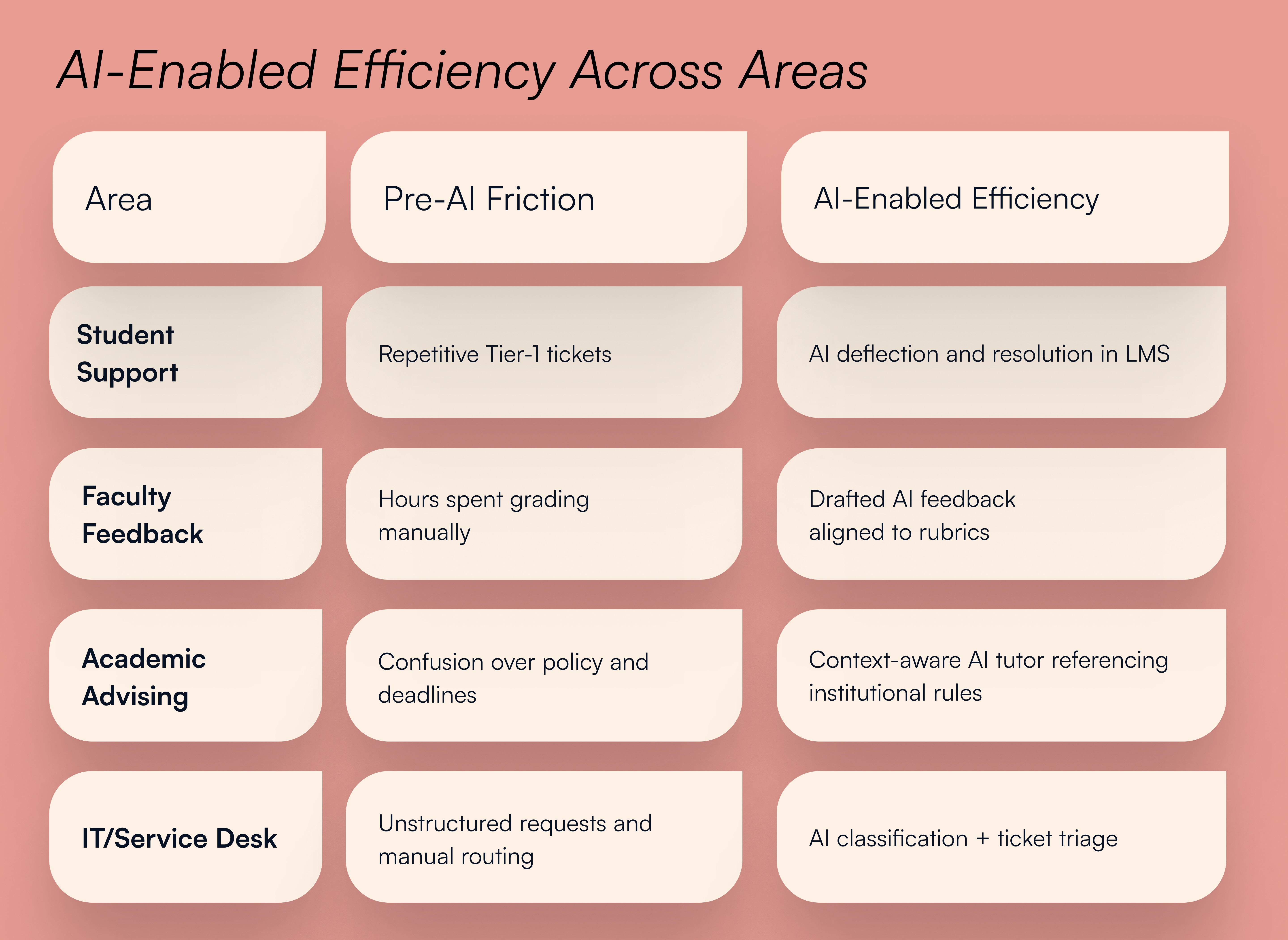
Each of these shifts translates into hours saved: hours that can be repurposed toward higher-impact work, more personalized assistant, and institutional savings.
3.2 Key Metrics Institutions Should Track
LearnWise surfaces operational metrics that directly support institutional KPIs. Common measures include:
Student Engagement & Self-Service
- AI interactions per user
- % of successful AI resolutions without human escalation
- Content accessed or requested via the AI Tutor tool
- Usage by platform (LMS, portal, SharePoint)
Faculty & Staff Time Savings
- Average time to feedback delivery
- % of submissions using AI-suggested feedback
- Ticket resolution time (MTTR) before vs. after AI rollout
- Manual handoffs vs. automated resolutions
Financial Efficiency
- Support cost per student
- Time saved × hourly staff pay = cost offset
- License/tool consolidation through LearnWise-native functions
According to the 2025 EDUCAUSE AI Survey, nearly 40% of institutions report measurable time savings within the first two terms of AI deployment, yet less than half have built structured ways to report those gains.
LearnWise addresses this gap directly with downloadable reports and BI integrations that connect usage data to institutional dashboards.
3.3 Case Snapshot: TU Delft, Westminster, and NPTC [TABLE]
.jpeg)
3.4 Turning Metrics into Strategy
For CIOs, Heads of Digital, and strategy leads, LearnWise provides:
- Role-based dashboards (academic, IT, student support): dashboards tailored to different institutional roles, such as academic staff, IT, and student support. The platform recognizes users based on their roles (when logged into the LMS or student portal) and delivers personalized support and analytics relevant to those roles. The admin portal allows for customization of personal, team, and organizational settings, ensuring that each user or group sees the most relevant data and tools for their responsibilities.
- Customizable KPIs aligned to institution-wide goals: LearnWise’s Insights dashboard enables institutions to track and customize key performance indicators (KPIs) that align with their strategic goals. Administrators can monitor metrics such as AI resolution rates, conversation volumes, escalation rates, and user engagement. These KPIs can be filtered and segmented by assistant, date range, and other criteria, allowing institutions to focus on the metrics that matter most to their goals.
- Trend analysis for better resource allocation planning: The platform’s analytics tools provide trend analysis to support better resource allocation and planning. The Insights dashboard includes trend graphs and support trends, helping institutions identify common queries, peak usage times, and the impact of changes to the AI’s knowledge base. This data-driven approach enables more effective planning for staffing, budgeting, and platform improvements.
- Logs and reports to inform future staffing, budgeting, and platform decisions: LearnWise generates detailed logs and downloadable reports to inform future decisions. Administrators can export conversation logs, feedback, and escalation data in CSV or JSON formats. These reports can be used to analyze support demand, identify knowledge gaps, and justify staffing or budget adjustments. The platform also tracks report downloads for audit and compliance purposes.
Efficiency becomes more than anecdotal. It becomes measurable and reportable, unlocking credibility with leadership and long-term funding pathways.
Laden Sie die Studie herunter


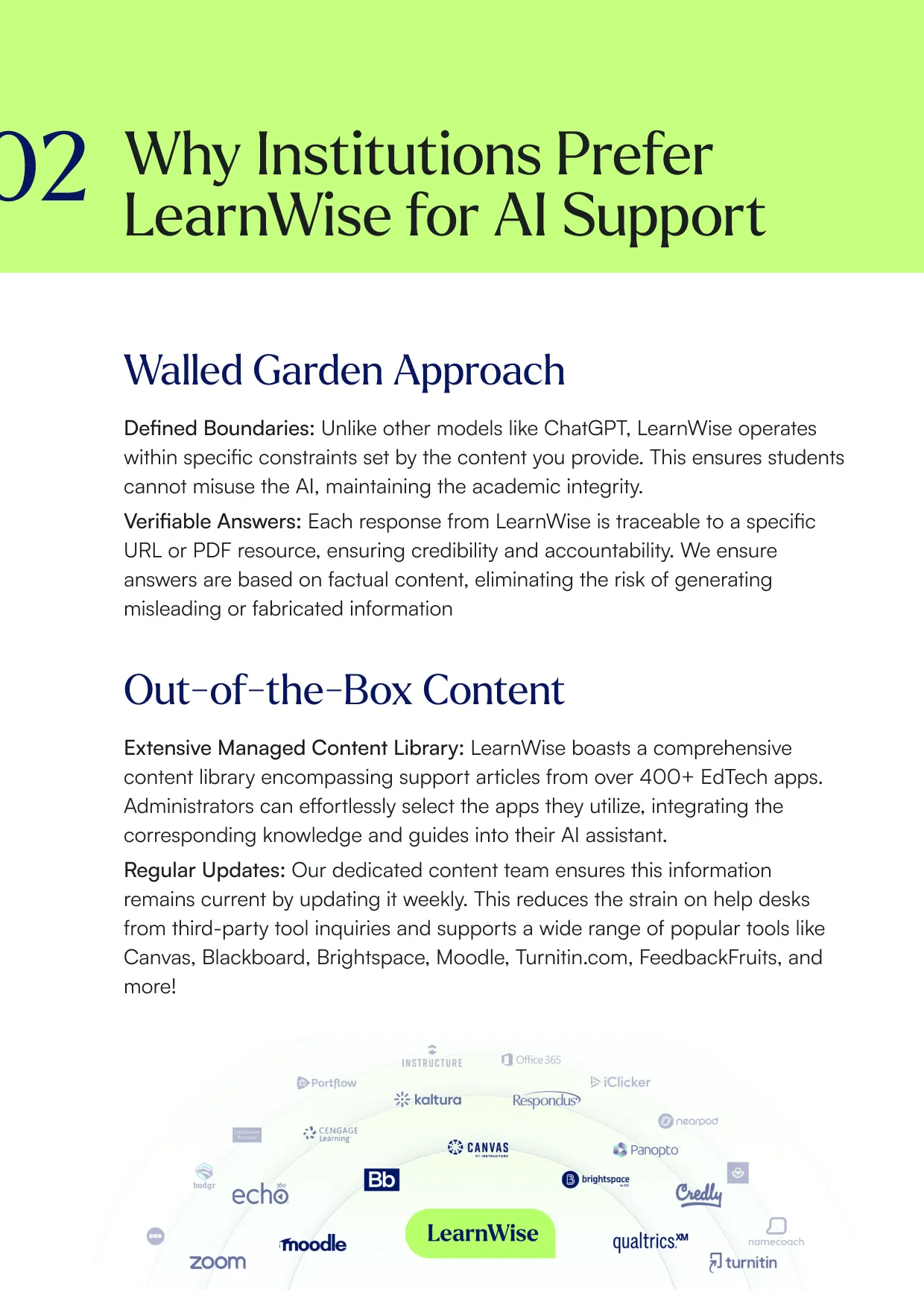
Whitepaper herunterladen


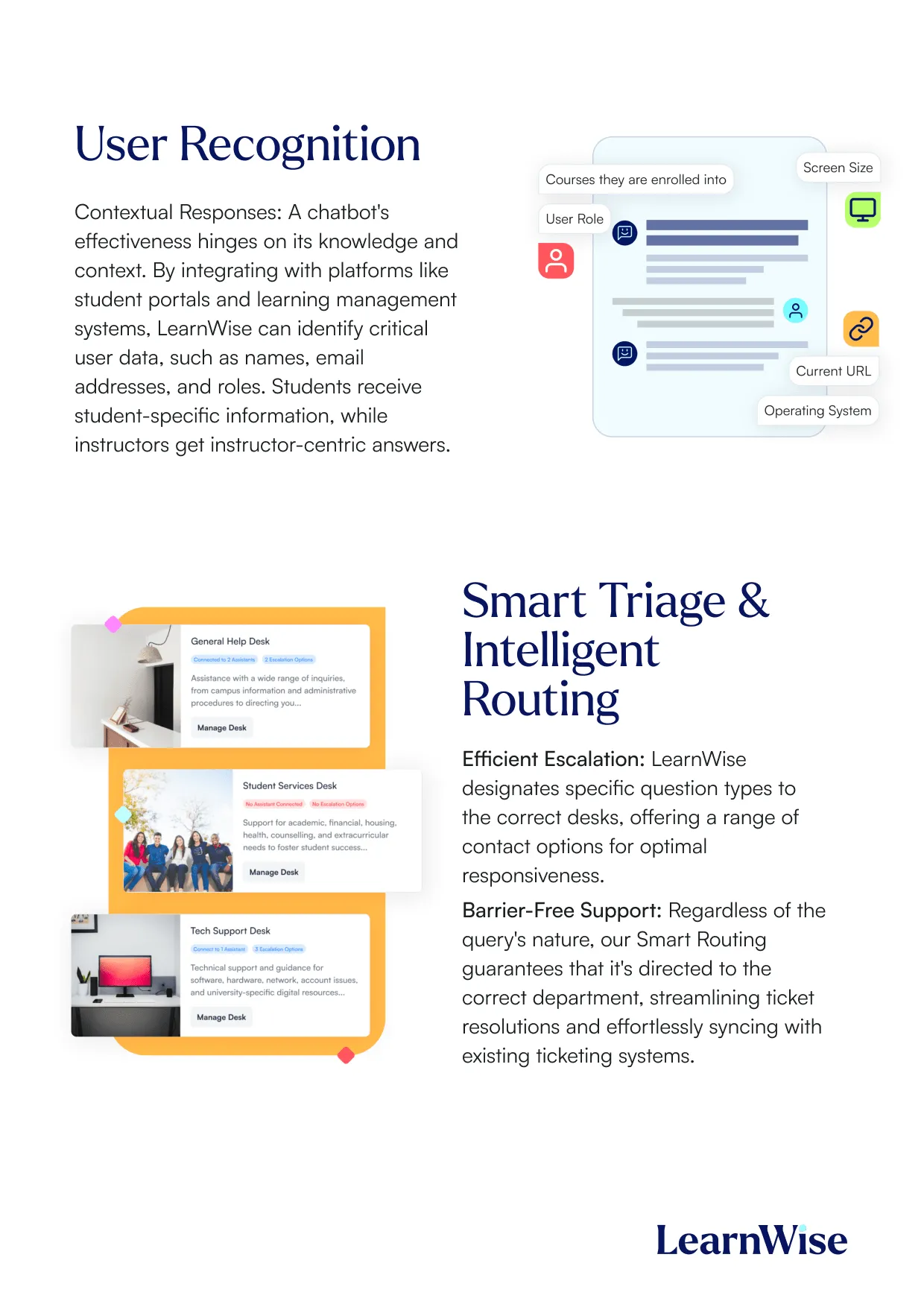

Chapter 4: Real-World Outcomes: Partner Institutions Putting Efficiency First
When it comes to operational efficiency, theoretical benefits mean little without real-world proof. That’s why LearnWise AI partners with institutions across the UK and Europe to implement, monitor, and improve AI-driven solutions within live academic and support environments.
This chapter highlights how forward-thinking institutions are using LearnWise to reduce workload, unlock time savings, and streamline service delivery without disrupting academic integrity or student experience.
4.1 TU Delft Extension School: Scalable, Multilingual AI Support
The TU Delft Extension School's deployment of LearnWise AI didn’t just reduce support tickets—it established a blueprint for delivering multilingual, always-on assistance to a global learner base with minimal IT lift.
By anchoring their AI assistant LiLLian in approved institutional knowledge and launching first in the highest-volume support channel (the Learning for Life website), TU Delft was able to achieve rapid ROI and learner satisfaction while laying the foundation for broader transformation.
Unlike one-off bots or narrow tools, LearnWise allowed TU Delft to:
- Deploy in weeks without deep custom development
- Control knowledge sources and audit prompts centrally
- Surface actionable analytics to improve institutional content
With over 1,300 AI-generated answers delivered and a 97.9% resolution rate, the pilot validated that operational efficiency doesn't require trade-offs in trust or quality. Today, TU Delft is preparing to scale LearnWise across its full online portfolio—including OpenEdX—and exploring internal use cases for academic and staff-facing assistants.
The key insight? AI doesn’t replace support, it expands its reach. TU Delft’s experience proves that with the right platform, even a small team can support tens of thousands of global learners efficiently, equitably, and securely.
4.2 University of Westminster: Course-Aware Tutoring and Feedback Automation
The University of Westminster, home to over 20,000 students from more than 140 countries, sought to improve access to academic support and streamline the learning experience—especially for its diverse, global student base. Traditional office hours and siloed resource platforms weren’t meeting students’ evolving needs, and academic staff were overwhelmed by repetitive support requests and limited visibility into how students were engaging with course materials.
A Strategic Deployment of AI
To address these challenges, Westminster implemented LearnWise AI across three key areas:
- Help Desk Pilot: The university’s first experiment with AI involved embedding a general-purpose assistant on its learning blog. However, early student feedback revealed a need for course-specific support, not just generic IT or site guidance.
- Library Assistant “Liby”: Trained on hundreds of LibGuides, Liby enabled students to navigate library resources using natural language questions, significantly improving discoverability and reducing librarian workload.
- Course Tutor “Maia”: Deployed directly within Blackboard, Maia gave students instant access to assessment information, deadlines, and quiz generation tools, all within the course environment. Students could revise, clarify academic expectations, and build study materials on demand.
“Academic staff can now see the kinds of questions students are asking. It’s offering insight into how they study and revise, something we couldn’t see before.”
— Gunter Saunders, Associate Director, Digital Engagement, University of Westminster
Outcomes: Visibility, Insight, and Engagement
LearnWise’s AI deployment didn’t just reduce help requests: it transformed how faculty and administrators understood student engagement. Top student interactions involved:
- Clarifying assignment deadlines and requirements
- Generating practice quizzes aligned to module content
- Navigating library resources more effectively
Faculty reported improved understanding of students’ misconceptions, study patterns, and frequently misunderstood criteria. These insights supported real-time course improvement and informed staff discussions about broader AI rollout across departments.
Student feedback was notably positive, particularly around Maia’s ability to simplify study prep and support self-paced learning. Meanwhile, Liby drove usage of previously underutilized academic content by surfacing it through chat, rather than forcing students to search multiple systems.
Blick in die Zukunft
Westminster’s success sparked interest across leadership and support units. The institution now plans to expand LearnWise across more academic modules, integrate AI into student services and mental health pathways, and explore new use cases for staff development and internal knowledge management.
This deployment illustrates how AI can support academic discovery, equity, and operational efficiency—not by replacing staff, but by surfacing hidden resources, freeing up academic capacity, and making institutional knowledge more accessible.
4.3 NPTC Group of Colleges: Multi-Channel AI Across Moodle, SharePoint, and the Web
NPTC Group of Colleges, one of Wales’ largest further education institutions, serves a geographically dispersed and linguistically diverse population. With limited internal capacity and no in-house chatbot development team, the institution needed a scalable support model that could serve both students and staff, across multiple platforms, and in both English and Welsh.
Their challenge was more than a support burden—it was a question of operational agility. Repetitive queries, disjointed systems, and duplicated staff effort were hampering everything from student onboarding to HR policy access.
From Fragmentation to Function: How LearnWise Enabled Scalable, Multilingual Support
In 2025, NPTC partnered with LearnWise to launch a multilingual AI assistant, branded Enfys (Welsh for “rainbow”) across its website, Microsoft SharePoint, and later its Moodle environment.
The rollout was remarkably fast: the first deployment went live in just two weeks. NPTC’s team chose a phased approach, starting with high-traffic student pages before expanding to internal systems.
LearnWise's platform architecture allowed for:
- Consistent bilingual responses in English and Welsh
- Shortcut buttons for rapid access to popular queries (e.g. open days, applications, apprenticeships)
- Policy retrieval via SharePoint for HR and admin staff
- In-Moodle academic support to assist learners with course navigation and revision needs
“We placed the chatbot on Moodle to help students navigate their course content and access 24/7 support. It’s helped increase engagement and personalise the learning experience... we’re also gaining valuable insights into areas where additional teaching focus may be needed.”
— Nicola Brandon, Director of Digital Innovation in Teaching and Learning, NPTC Group of Colleges
Outcomes: Reduced Friction, Increased Insight
The deployment of Enfys delivered immediate operational benefits:
- Workload relief for marketing and admin staff, as Enfys deflected routine website and social media questions
- Faster internal responses, with staff using the SharePoint assistant to retrieve HR policies without needing helpdesk support
- Real-time learning analytics, uncovering patterns of student confusion that helped tutors address knowledge gaps in their teaching
- Content improvement, with AI-generated usage data highlighting outdated or unclear institutional materials across platforms
Most importantly, NPTC didn't need to “rip and replace” its systems. By embedding AI into the tools staff and students already used - Moodle, SharePoint, and the web -LearnWise extended support and visibility without introducing friction.
Looking Ahead: Platform Thinking, Not Point Solutions
The NPTC team has since begun expanding Enfys into additional digital spaces, including:
- Library support
- Staff development portals
- Personalized dashboards and in-course tutor agents
This shift reflects a broader institutional strategy: to replace fragmented helpdesk systems and siloed chatbots with a single, AI-powered support layer that works across departments, roles, and languages.
NPTC’s success shows what’s possible when AI moves from novelty to infrastructure: faster support, clearer communication, and staff freed up to focus on what matters most.
4.4 What These Stories Show: A Blueprint for AI-Driven Efficiency at Scale
Despite their differences in geography, scale, and digital maturity, the institutions highlighted - TU Delft Extension School, University of Westminster, and NPTC Group of Colleges - share a common outcome: they’ve successfully used LearnWise AI not as a bolt-on solution, but as an integrated operational asset embedded within the fabric of their existing systems.
These institutions didn’t need to overhaul their tech stack, re-train their entire staff base, or compromise pedagogical control. Instead, they focused on deploying AI where it adds the most measurable value: reducing staff burden, accelerating access to knowledge, and surfacing data-driven insights to guide institutional improvement.
Here’s what their stories reveal:
1. Fewer Manual Responses, Greater Focus on High-Value Work
At TU Delft, a support team serving hundreds of thousands of global learners was able to resolve nearly 98% of questions through AI alone. At Westminster, tutors gained visibility into student knowledge gaps, helping them intervene more meaningfully rather than simply replying to repetitive clarification requests. And at NPTC, administrative staff saw routine helpdesk load drop, without increasing headcount.
Across these examples, LearnWise enabled institutions to automate the routine so humans could focus on the complex.
2. Faster Turnaround and Support Response Times
Speed matters, especially at scale. Whether a student is trying to find an assignment deadline or a staff member needs a link to a travel policy, delay introduces friction and frustration.
In all three cases, LearnWise delivered instant, context-aware responses within the LMS, SharePoint, or public-facing website. There’s no need to navigate 10 tabs or send 5 emails. When AI is placed inside the tools people already use, institutions remove barriers to support and enable real-time action.
3. Better Content Discoverability
Every institution had the same hidden challenge: they already had the answers—but they were buried in PDFs, LibGuides, siloed folders, or static FAQ pages. LearnWise turned that fragmented content into a conversational knowledge system, allowing students and staff to ask questions in natural language and receive precise, sourced answers.
This doesn’t just improve the user experience. It drives content governance. TU Delft and NPTC both used LearnWise analytics to flag outdated articles and identify where new documentation was needed. AI becomes a feedback loop, not just a helpdesk.
4. Actionable Analytics and Institutional Insight
From Westminster’s faculty learning how students were preparing for assessments, to NPTC surfacing demand for new policy materials, LearnWise revealed what institutions previously couldn’t see: how users actually engage with support systems.
This insight enables continuous improvement and deeper alignment between digital strategy and real-world needs.
5. Staff Time Reclaimed at Scale
Ultimately, all three institutions achieved what many AI pilots promise but few deliver: time recovery.
- Instructors at NPTC saved several hours per week on feedback
- Westminster staff reduced 1:1 clarification meetings by preempting questions via AI
- TU Delft support teams cut their human escalations to near zero—even while serving a global audience
These aren’t edge cases. They’re proof points that AI, when deployed inside core systems and aligned with institutional knowledge, can create meaningful operational efficiency.
Beyond the Plugin: Why LearnWise Platform Works
Unlike consumer tools or narrow-function chatbots, LearnWise is built for and within higher education systems. It lives in the LMS. It respects role-based access. It integrates with SharePoint and student portals. It retrieves institutional knowledge, not random web data. It tracks usage, flags gaps, and supports governance.
The result? AI that doesn’t feel like a pilot, but like infrastructure.
Across TU Delft, Westminster, and NPTC, LearnWise proved that institutions don’t need more tools. They need smarter systems that scale with them, saving time, improving access, and turning complexity into clarity.
Chapter 5: Avoiding AI Bloat -What Actually Improves Efficiency vs. Adds Complexity
Higher education doesn’t suffer from a lack of AI tools. It suffers from fragmentation.
Across institutions, AI experiments have taken off—but in siloed ways. One department uses a chatbot. Another runs an AI grading pilot. A third tests a tutoring assistant built on external content. The result? A tool landscape full of friction.
This fragmentation creates more problems than it solves: support duplication, prompt conflicts, uneven user experiences, poor integration, and governance gaps. The very tools designed to enhance efficiency often end up increasing complexity and cost.
5.1 What Does AI Bloat Look Like?
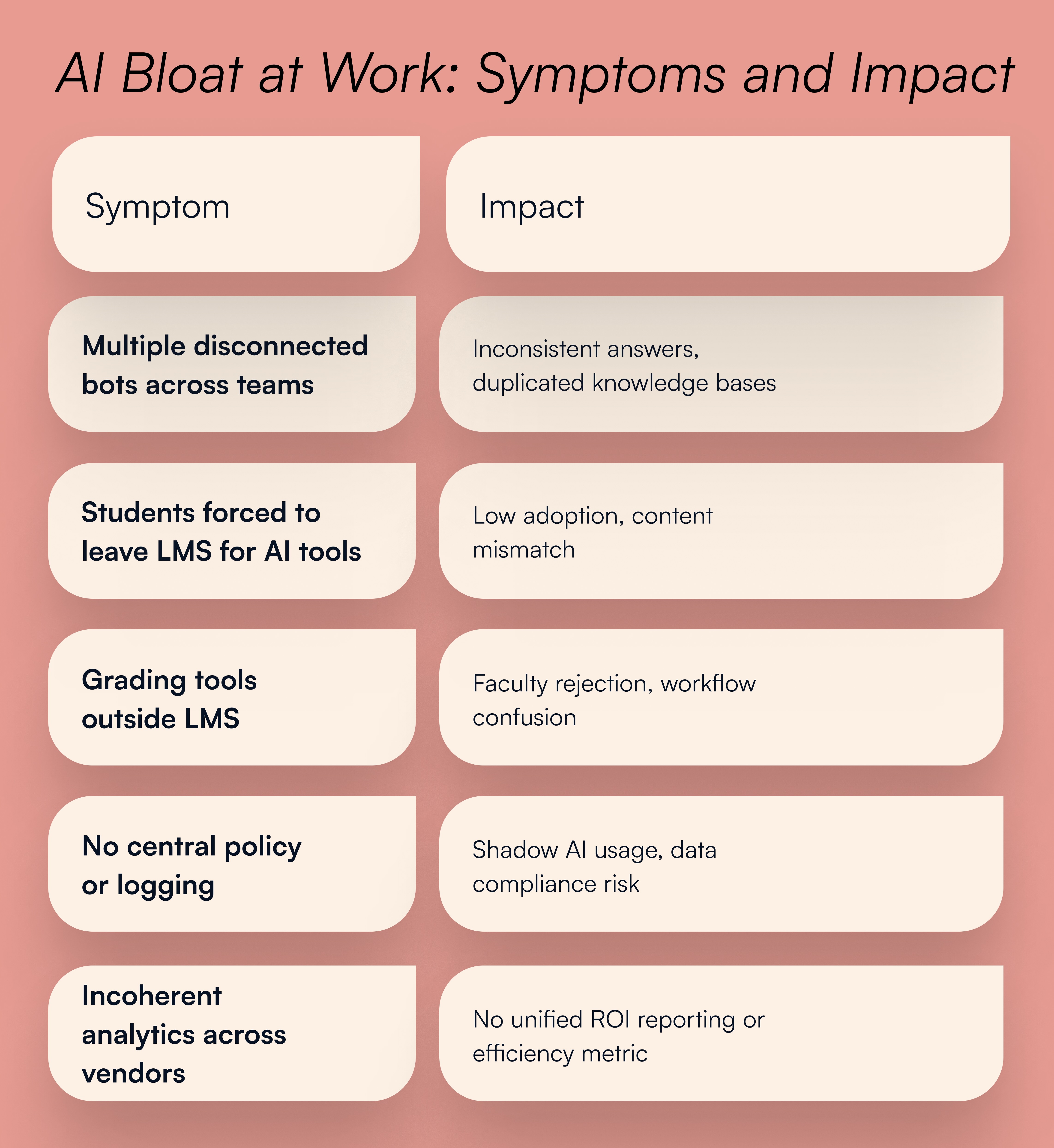
This is more than a usability issue. It’s a strategic inefficiency, one that risks eroding trust in AI adoption altogether.
5.2 What’s Missing: Agent Orchestration over Tool Saturation
True operational efficiency doesn’t come from piling on more tools. It comes from orchestration: connecting intelligent systems to share context, respond dynamically, and align with institutional policies.
In an orchestrated AI environment:
- A support query about a missed deadline references real course policies
- A grading assistant reflects the same tone and rubric expectations as the syllabus
- A tutoring session points students to institutional sources, not generic content
- Data is shared across assistants to improve routing, timing, and performance
- Prompts and usage are centrally auditable and adjustable
In this case, this tool works as a role- and context-aware AI layer, grounded in institutional systems, capable of adapting to student needs and faculty preferences in real time.
5.3 LearnWise: AI Without the Bloat
LearnWise is built for orchestration from the ground up.
It combines support, feedback, and tutoring into a unified AI platform, embedded directly within the LMS and institutional portals. This allows institutions to deploy fewer tools while achieving broader outcomes, without compromising control or compliance.
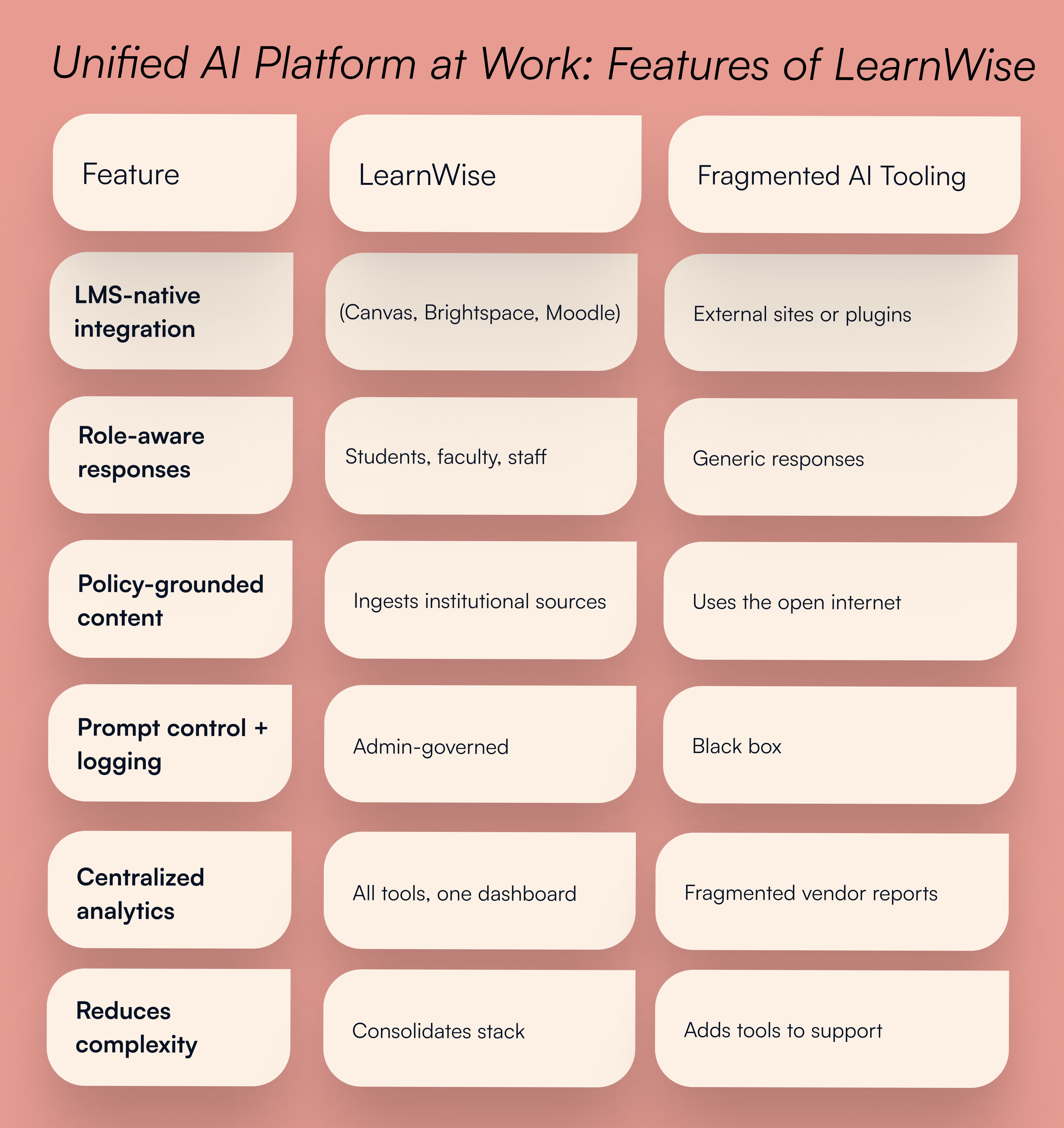
Instead of stitching together three or four vendors, LearnWise reduces surface area, simplifies procurement, and aligns user experience under one interface.
Laden Sie die Studie herunter



Whitepaper herunterladen




Chapter 6: CIO Playbook - How to Plan for AI-Powered Efficiency in 2026
With AI hype everywhere, the risk isn’t doing nothing. It’s doing everything at once, and then struggling to measure impact.
This chapter offers a concrete, step-by-step framework for IT leaders and digital transformation teams to build an efficiency-focused AI strategy that actually delivers on cost, time, and staff experience.
6.1 Start with the Right Framing: Efficiency Is Strategy
In many institutions, operational efficiency is still viewed as a secondary concern, something for finance or IT to optimize behind the scenes. But in 2026, that framing no longer holds. Efficiency is not a back-office metric. It’s a strategic imperative.
The institutions that will lead in the AI era are not the ones with the flashiest tools. They’re the ones that can demonstrably:
- Reduce staff burnout by minimizing repetitive, low-impact workload
- Shorten service response times without increasing headcount
- Improve feedback and learning support at scale, so students stay engaged and succeed
- Reclaim hours and budget to reinvest in pedagogy, innovation, and student services
- Align resources with outcomes, using AI to measure, surface, and fix institutional bottlenecks
AI isn’t just about innovation, it’s about resilience. With budgets under pressure, student expectations rising, and digital infrastructure becoming more complex, institutions can’t afford inefficiency. If your support team is answering the same question 50 times a week, or your faculty are copy-pasting the same rubric feedback, that’s not just a workload issue, but a leadership opportunity.
Efficiency, when framed correctly, becomes the lever for everything else:
- It’s how you scale without hiring.
- It’s how you improve student experience without overhauling your LMS.
- It’s how you build trust in AI: by showing real, measurable benefits.
And most importantly, efficiency is not about cutting corners, but about elevating human effort. When faculty, staff, and students spend less time chasing information or duplicating effort, they spend more time teaching, learning, and solving meaningful problems.
That’s why at LearnWise, operational efficiency isn’t an afterthought. It’s the starting point for institutional AI strategy, because if it doesn’t save time, improve clarity, or reduce burden, it’s not worth scaling.
Step 1: Audit Your Current Systems and Support Load
Before any AI deployment can drive meaningful efficiency, institutions need a clear picture of where friction lives today. Operational inefficiencies are often hidden in plain sight, buried in legacy workflows, duplicated tools, and siloed content.
This first step is about establishing a shared, cross-functional understanding of your current landscape:
Key Diagnostic Questions:
- Where are students most frequently getting stuck: registration? assignment submission? accessing course materials?
- Which tools do faculty use to give feedback? Are they integrated into the LMS or external?
- What’s the average volume of Tier-1 tickets per term? How many of these are repeatable, FAQ-style queries?
- How many tools are currently in use for:
- Delivering institutional knowledge?
- Student-facing support and helpdesk triage?
- Tutoring or study assistance?
- Grading and feedback workflows?
Once you’ve mapped this baseline, you’ll be equipped to identify:
- Redundancies to consolidate
- Bottlenecks to automate
- Use cases where AI can deliver time savings without requiring major behavioral change
📌 Use LearnWise’s free diagnostic template to map friction points across roles. [generate free diagnostic template]
Step 2: Consolidate Redundant Tools
One of the fastest paths to operational efficiency is simplification.
Over the past decade, many institutions have accumulated tool stacks organically, adopting different chatbots for admissions, ticketing systems for IT, grading plugins for feedback, and tutoring tools outside the LMS. This results in tool sprawl, increasing the workload for IT, duplicating efforts across departments, and making it harder to govern data, access, and spending.
The goal of Step 2 is not just to reduce cost, but to reclaim clarity. Where possible, you want to consolidate systems that:
- Perform overlapping functions
- Live outside the LMS ecosystem
- Lack proper analytics, role awareness, or governance features
- Require manual upkeep or frequent re-training
Consolidation Questions to Ask
- How many vendors provide support/chatbot services across student-facing teams?
- Are you using more than one tool for:
- Knowledge base delivery?
- Feedback and grading support?
- Course-level tutoring or study help?
- Are these tools fully integrated with your LMS (Canvas, Brightspace, Moodle), or are users sent off-platform?
- Do these tools share usage analytics, prompt logs, and training data with your central IT or teaching & learning teams?
- Can these tools be governed centrally (e.g., access controls, prompt review, SSO)?
If the answer to any of these is no, you're likely dealing with AI bloat or redundant spend.
How LearnWise Enables Consolidation
Institutions using LearnWise AI have successfully retired or downgraded:
- External FAQ/chatbot tools like Ivy.ai or Intercom
- Standalone grading platforms like TimelyGrader
- Generic tutoring apps like Mindgrasp or StudyGPT
- Siloed helpdesk systems not integrated into their LMS
Because LearnWise delivers AI support, tutoring, and feedback in one platform, integrated directly into the LMS and portals, IT can reduce vendor contracts, streamline security reviews, and unify analytics across all student interactions.
Budget Conversation
Tool consolidation isn’t just about operations, but a strategic budgeting move. Here’s how you position it:
Legacy Cost CenterWith LearnWise AI3–4 separate tool licenses1 unified license (fixed-cost)3–4 vendor onboarding & renewalsSingle contract + onboarding cycleMultiple compliance reviewsOne ISO 27001/GDPR-compliant vendorFragmented data viewsUnified analytics + prompt logging
Many institutions find they can save 25–40% on their annual edtech spend in these categories, while improving adoption and visibility.

Step 3: Build Your AI Governance Structure
- Appoint a cross-functional AI working group: IT, teaching & learning, student experience, legal
- Assign prompt review ownership, audit logging policy, and rollout signoff workflows
- Create a central knowledge hub with approved tools, privacy policies, and training materials
Step 4: Define Your Efficiency Metrics
Set clear baseline KPIs before AI deployment:
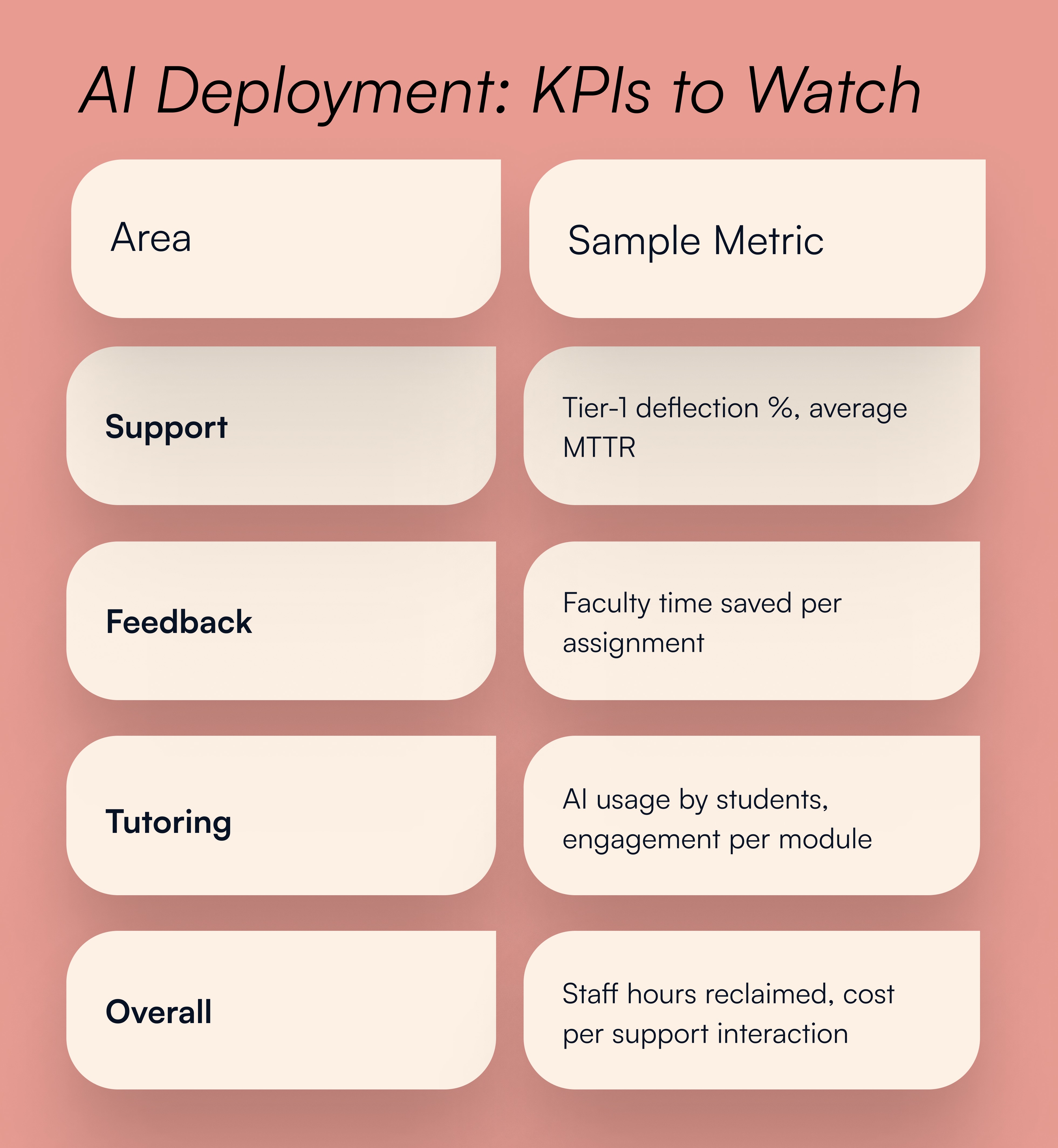
Step 5: Plan Your Rollout in Phases
- Phase 1: Deploy AI support assistant in LMS or portal
- Phase 2: Enable feedback assistant for faculty grading workflows
- Phase 3: Add AI tutor for course-level engagement
- Phase 4: Monitor adoption, refine content, expand access
💡 LearnWise can deploy in under 5 weeks with minimal IT lift, thanks to LTI 1.3, SSO, and pre-built connectors.
6.3 From IT Initiative to Institutional Strategy
When CIOs lead with a platform approach and tie AI to real-time metrics, AI becomes more than a technical enhancement—it becomes a campus-wide efficiency engine.
LearnWise provides:
- Enterprise-ready architecture and security
- Centralized analytics and logging
- Support for governance, policy, and planning
- Fast time-to-value with live implementations across UK/EU institutions
Efficiency isn’t just an IT metric, it’s your strategic edge in 2026.
Chapter 7: Your AI Efficiency Toolkit
Whether you’re planning a pilot, scaling an existing AI deployment, or rationalizing a fragmented tool stack, the most effective institutions use shared frameworks and checklists to guide decisions, especially when AI is tied to efficiency, not just innovation.
This chapter shares one core, ready-to-use resource to help you evaluate vendors, and two strategic exercises to align internal teams and set a measurable foundation for operational AI.
7.1 AI Vendor Evaluation Checklist
Selecting the right AI vendor isn’t just a technical decision—it’s a governance and strategic alignment issue. Institutions need confidence that vendors meet compliance requirements, integrate deeply into learning ecosystems, and can scale responsibly.
This checklist helps procurement teams, CIOs, and teaching & learning leads score and compare vendors across seven critical dimensions:

Pro Tip: Score vendors across a 1–5 scale per criterion and use weighted scoring based on institutional priorities (e.g. security = 25%, cost predictability = 15%).
7.2 Strategic Planning Exercise: The Friction Audit
Instead of templated policies or lengthy governance packs, we recommend starting with a simple internal workshop.
Bring together stakeholders from academic affairs, IT, student services, and support—and ask:
- Where are people (students, staff, faculty) losing time?
- What are the most repetitive or high-volume support questions?
- Where does content already exist but isn’t accessible?
The goal: identify 3–5 areas where AI can save time or reduce manual effort, with no disruption to existing systems. You can use our AI Efficiency Diagnostic Template (see Step 1 of the CIO Playbook) to guide this session.
7.3 Define Your Starting Metrics
You don’t need complex dashboards to start measuring impact. Just define a few core metrics before rollout begins:
- Tier-1 support ticket volume
- Faculty time spent on grading per week
- AI usage within the LMS (student queries, tutor usage)
- Support cost per student or staff hour saved
Capture these early, so you can compare post-deployment. Tools like LearnWise provide these out of the box, but even a spreadsheet works—what matters is tracking improvement.
Scaling AI with Intention
Operational efficiency is often the quiet engine behind successful innovation. It’s not just about saving hours or shaving budgets but about creating the conditions for educators and staff to do their best work.
This guide doesn’t promise silver bullets or overnight transformation. Instead, it offers a way to start: by making knowledge easier to access, support easier to deliver, and teaching easier to scale. It’s about turning AI from a question mark into an infrastructure layer, quietly embedded, broadly useful, and institutionally aligned.
Whether you download the evaluation checklist, run a friction audit, or simply define your first few metrics, you’re already one step closer to delivering AI that works for people, not just platforms.





.png)
%20(1).png)
%20(1).png)
